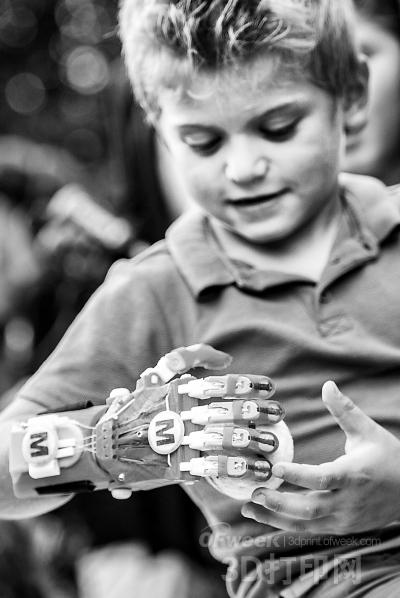In recent years, the revolutionary manufacturing technology of 3D printing has been widely used in the medical field. On August 17, a congenitally disabled French boy received a tailor-made 3D printed fake hand.

According to French media reports, Mark Sans, a 6-year-old boy from Isère in eastern France, is born without a right hand. With the help of e-Nable, a nonprofit organization dedicated to providing 3D printed prosthetics for the disabled, Mark Sans got a fake hand made with a 3D printer according to his palm size. This 3D hand is made of plastic, sponge, elastic band, 8 screws and velcro. It looks like a glove. Mark Sans does not need to undergo any transplant surgery, just use a Velcro to fix it on his arm and use it directly, and control the "finger" flexion and extension by bending the wrist up and down. Shortly after wearing the fake hand, Mark Sans realized a simple action such as throwing a tennis ball with a "right hand".
Traditional medical prostheses are generally costly, and as they age, children and adolescents in growth and development will have to change their prostheses frequently, resulting in significant costs. The production of a standard 3D printing prosthetic hand costs between 50 euros and 200 euros, and the materials used are easily repaired and reused. Once the prosthesis is damaged or its size is no longer suitable for the user, you can always use the 3D printer to recreate it.
In addition to reducing the cost of use, the personalized design also makes the 3D printed prosthesis bid farewell to the ugly, heavy shape of the traditional medical prosthesis, more like a toy. According to Mark Sans's own wishes, his 3D printed "right hand" is mainly composed of bright orange, green and blue colors, and is printed with a unique symbol symbolizing "superheroes".
Founded in the United States, this nonprofit organization aims to provide open source digital design models for 3D printed prosthetics and to bring together 3D printer volunteers around the world to provide 3D printed prosthetics for those with imperfect fingers, hands or arms to improve them. life. To date, the organization has provided approximately 2,000 3D printed prostheses to children and adults with disabilities in 37 countries.
Since the signage system is divided into multiple subsystems, there are also many classification of identification cards.It can be broadly divided into the following categories:
1. According to the material classification, the common material is, stainless steel sign/acrylic sign/PVC sign/aluminum profile sign/other metal sign/different material combination sign;
2. According to shapes, the commonly used shapes are square, circle, triangle, polygon, profile-shaped, etc.
3. According to the purpose, it is generally divided into two kinds of luminescence and non-luminescence.
Sign Plates,Building Indoor Signage,Office Door Signage,Curved Aluminum Slider Sign
Chengdu GodShape Sign Co., Ltd , https://www.signsgs.com